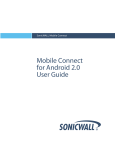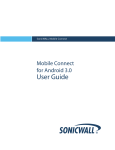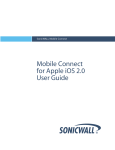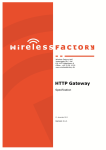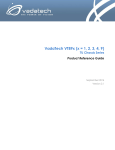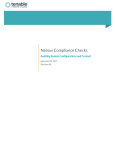Download User Guide - SonicWALL
Transcript
SonicWALL Mobile Connect Mobile Connect for OS X 3.0 User Guide Notes, Cautions, and Warnings NOTE: A NOTE indicates important information that helps you make better use of your system. CAUTION: A CAUTION indicates potential damage to hardware or loss of data if instructions are not followed. WARNING: A WARNING indicates a potential for property damage, personal injury, or death. © 2014 Dell Inc. Trademarks: SonicWALL™, Aventail™, SonicWALL Mobile Connect™, and all other SonicWALL product and service names and slogans are trademarks of SonicWALL, LLC, a wholly owned subsidiary of Dell. 2014 – 5 P/N 232-002520-00 Rev. A Table of Contents . Table of Contents . . . . . . . . . . . . . . . . . . . . . . . . . . . . . . . . . . . . . . . . . . . . . . . . . . . . . . . . . . . . 3 Chapter 1. Mobile Connect for OS X . . . . . . . . . . . . . . . . . . . . . . . . . . . . . . . . . . . . . . . . . . . . . . . 5 How Mobile Connect Works . . . . . . . . . . . . . . . . . . . . . . . . . . . . . . . . . . . . . . . . . . . . . . . . . . . . . . . . . . . . 5 Prerequisites . . . . . . . . . . . . . . . . . . . . . . . . . . . . . . . . . . . . . . . . . . . . . . . . . . . . . . . . . . . . . . . . . . . . . . . . 5 Apple Product Support. . . . . . . . . . . . . . . . . . . . . . . . . . . . . . . . . . . . . . . . . . . . . . . . . . . . . . . . . . . . . . . . . . . . . . . 6 Dell SonicWALL Appliance Support . . . . . . . . . . . . . . . . . . . . . . . . . . . . . . . . . . . . . . . . . . . . . . . . . . . . . . . . . . . . 6 Required Network Information . . . . . . . . . . . . . . . . . . . . . . . . . . . . . . . . . . . . . . . . . . . . . . . . . . . . . . . . . . . . . . . . . 6 Chapter 2. Installing Mobile Connect . . . . . . . . . . . . . . . . . . . . . . . . . . . . . . . . . . . . . . . . . . . . . . 9 Chapter 3. Using Mobile Connect . . . . . . . . . . . . . . . . . . . . . . . . . . . . . . . . . . . . . . . . . . . . . . . . 11 Create a Connection . . . . . . . . . . . . . . . . . . . . . . . . . . . . . . . . . . . . . . . . . . . . . . . . . . . . . . . . . . . . . . . . . 11 Create a Connection to Dell SonicWALL Firewall and SRA Appliances . . . . . . . . . . . . . . . . . . . . . . . . . . . . . . . . 12 Create a Connection to Dell SonicWALL E-Class SRA Appliances . . . . . . . . . . . . . . . . . . . . . . . . . . . . . . . . . . . 14 Connect to the Mobile Connect Server . . . . . . . . . . . . . . . . . . . . . . . . . . . . . . . . . . . . . . . . . . . . . . . . . . . 16 Configure Connect Mobile Connect Preferences . . . . . . . . . . . . . . . . . . . . . . . . . . . . . . . . . . . . . . . . . . . 18 Mobile Connect Help . . . . . . . . . . . . . . . . . . . . . . . . . . . . . . . . . . . . . . . . . . . . . . . . . . . . . . . . . . . . . . . . . 19 URL Control Syntax and Parameters . . . . . . . . . . . . . . . . . . . . . . . . . . . . . . . . . . . . . . . . . . . . . . . . . . . . 20 Add Profile Command . . . . . . . . . . . . . . . . . . . . . . . . . . . . . . . . . . . . . . . . . . . . . . . . . . . . . . . . . . . . . . . . . . . . . . 20 Connect Command . . . . . . . . . . . . . . . . . . . . . . . . . . . . . . . . . . . . . . . . . . . . . . . . . . . . . . . . . . . . . . . . . . . . . . . . 21 Disconnect Command . . . . . . . . . . . . . . . . . . . . . . . . . . . . . . . . . . . . . . . . . . . . . . . . . . . . . . . . . . . . . . . . . . . . . . 22 Callback URL. . . . . . . . . . . . . . . . . . . . . . . . . . . . . . . . . . . . . . . . . . . . . . . . . . . . . . . . . . . . . . . . . . . . . . . . . . . . . 23 Configure Client Certificates . . . . . . . . . . . . . . . . . . . . . . . . . . . . . . . . . . . . . . . . . . . . . . . . . . . . . . . . . . . 24 Configuring a Connection to Dell SonicWALL E-Class SRA Appliances. . . . . . . . . . . . . . . . . . . . . . . . . . . . . . . . 24 Configure Connect on Demand . . . . . . . . . . . . . . . . . . . . . . . . . . . . . . . . . . . . . . . . . . . . . . . . . . . . . . . . . 25 Chapter 4. Monitor Mobile Connect . . . . . . . . . . . . . . . . . . . . . . . . . . . . . . . . . . . . . . . . . . . . . . 27 Chapter 5. Troubleshooting Mobile Connect . . . . . . . . . . . . . . . . . . . . . . . . . . . . . . . . . . . . . . . 29 Table of Contents | 3 4 | SonicWALL Mobile Connect for OS X User Guide Chapter 1 Mobile Connect for OS X SonicWALL Mobile Connect for OS X is an app for Apple Mac notebooks and desktops running OS X Mavericks (10.9+) that enables secure, mobile connections to private networks protected by Dell SonicWALL security appliances. How Mobile Connect Works Modern business practices increasingly require that users be able to access any network resource (files, internal websites, etc.), anytime, anywhere. At the same time, ensuring the security of these resources is a constant struggle. While most users are aware that they must protect PCs from network security risks, this security awareness does not always extend to Mac devices like the MacBook Air and MacBook Pro. And yet, Macs are increasingly subject to security attacks. Furthermore, remote Mac users may often use insecure, untrusted, public WiFi hotspots to connect to the Internet. It is therefore a challenge to provide secure, mobile access while still guarding against the inherent security risks faced by mobile users. The SonicWALL Mobile Connect app for OS X provides secure, mobile access to sensitive network resources. Mobile Connect establishes a Secure Socket Layer Virtual Private Network (SSL VPN) connection to private networks that are protected by Dell SonicWALL security appliances. All traffic to and from the private network is securely transmitted over the SSL VPN tunnel. After installing SonicWALL Mobile Connect from the Mac App Store, to get started with Mobile Connect: 1. Ensure the Dell SonicWALL SRA or firewall appliance that will be used by Mobile Connect is connected to the network. 2. Configure Network Information (server name, username, password, etc.). 3. Mobile Connect establishes a SSL VPN tunnel to the Dell SonicWALL security appliance. 4. You can now access resources on the private network. All traffic to and from the private network is securely transmitted over the SSL VPN tunnel. Prerequisites The following sections describe prerequisites for SonicWALL Mobile Connect: • “Apple Product Support” on page 6 Mobile Connect for OS X | 5 • “Dell SonicWALL Appliance Support” on page 6 • “Required Network Information” on page 6 Apple Product Support SonicWALL Mobile Connect for OS X is supported on all Mac models running OS X Mavericks (10.9), available as a free upgrade. Please see the following web site for information on how to upgrade to OS X Mavericks: http://www.apple.com/osx/how-to-upgrade/ The following Mac models are compatible with OS X Mavericks: • • • • • • • iMac (Mid 2007 or newer) MacBook (Late 2008 Aluminum or Early 2009 or newer) MacBook Pro (Mid/Late 2007 or newer) MacBook Air (Late 2008 or newer) Mac mini (Early 2009 or newer) Mac Pro (Early 2008 or newer) Xserve (Early 2009) Dell SonicWALL Appliance Support SonicWALL Mobile Connect is a free app, but requires a concurrent user license on one of the following Dell SonicWALL solutions in order to function properly: • Dell SonicWALL firewall appliances including the TZ, NSA, E-Class NSA running SonicOS 5.8.1.0 or higher • Dell SonicWALL SRA appliances running 5.5 or higher • Dell SonicWALL Aventail E-Class Secure Remote Access (SRA) appliances running 10.5.4 or higher Required Network Information To use Mobile Connect, you will need the following information from your network administrator or IT Support: • Server name or address – This is either the IP address or URL of the SSL VPN server that you will connect to. • Username and password – Typically, you will be required to enter your username and password, although some connections may not require this. • Domain name – The domain name of the SSL VPN server. Mobile Connect may be able to automatically determine this when it first contacts the server, or there may be multiple domains that can be selected. DNS Domain Settings on Appliances Before Mobile Connect users will be able to access the private network, the network administrator must configure the DNS Domain on the Dell SonicWALL appliance. When the Mobile Connect user accesses a URL on the private network, the configured DNS domain is used to resolve the hostname lookup. For public domains that do not match the configured DNS domain, the DNS server for the Wi-Fi or cellular network is used. 6 | SonicWALL Mobile Connect for OS X User Guide Note The Mobile Connect user does not need to perform any configuration tasks related to DNS. The following information is for SonicWALL network administrators. The DNS Domain configuration process varies, depending on the type of Dell SonicWALL appliance being used: • Dell SonicWALL firewall appliances – On the SSL VPN > Client Settings page, enter the DNS domain name in the DNS Domain field. • Dell SonicWALL SRA appliances – The DNS domain can be configured either globally, at the group level, or at the individual user level: – Global level: On the Network > DNS page, enter the DNS domain name in the DNS Domain field. – Group level: On the Users > Local Groups page, click the edit icon for the group. Click on the NX Settings tab and enter the DNS domain the DNS Domain field. – User level: On the Users > Local Users page, click the edit icon for the user. Click on the NX Settings tab and enter the DNS domain the DNS Domain field. • Dell SonicWALL E-Class SRA appliances – The DNS domain can be configured either globally or for specific IP address pools: – Global level: From the main navigation menu in the E-Class SRA Management Console (AMC), click Network Settings. In the Name resolution area, click Edit. The Configure Name Resolution page appears. Enter the DNS domain name in the Search domains field. – IP address pool level: From the main navigation menu in the AMC, click Services. Under Access services, in the Network tunnel service area, click Configure. The Configure Network Tunnel Service page appears. Click the name of the IP address pool you want to edit. The Configure IP Address Pool page appears. To the right of the Advanced heading, click the arrow icon. Select the Customize default settings checkbox and enter the DNS domain name in the Search domains field. Prerequisites | 7 8 | SonicWALL Mobile Connect for OS X User Guide Chapter 2 Installing Mobile Connect SonicWALL Mobile Connect is installed through the Mac App Store. 1. On your Mac click the App Store icon. 2. In the Search field, enter SonicWALL Mobile Connect, and tap Enter. 3. In the search results, select SonicWALL Mobile Connect. 4. Tap Free and then Install. The app will install on your Mac. When installation is complete, the SonicWALL Mobile Connect icon will appear in your Applications folder and in Launchpad. Note If you encounter an error when attempting to download SonicWALL Mobile Connect, please see the Mac App Store Support web site, where you can find troubleshooting procedures and instructions on how to report the issue to Apple Support if necessary: http:// www.apple.com/support/mac/app-store/ Installing Mobile Connect | 9 10 | SonicWALL Mobile Connect for OS X User Guide Chapter 3 Using Mobile Connect The following sections describe how to use SonicWALL Mobile Connect: • • • • “Create a Connection” on page 11 “Connect to the Mobile Connect Server” on page 16 “Configure Connect Mobile Connect Preferences” on page 18 “Configure Connect on Demand” on page 25 Create a Connection The process of creating a Mobile Connect connection is slightly different depending on which type of Dell SonicWALL appliance you are connecting to. The following sections describe how to create a connection: • “Create a Connection to Dell SonicWALL Firewall and SRA Appliances” on page 12 • “Create a Connection to Dell SonicWALL E-Class SRA Appliances” on page 14 Using Mobile Connect | 11 Create a Connection to Dell SonicWALL Firewall and SRA Appliances 1. The first time you launch Mobile Connect, you must add a VPN connection before you can connect. Select Add connection from the Connection popup menu. 2. You will then be presented with the screen to begin your first connection to the Dell SonicWALL firewall or appliance: – Name: Enter a descriptive name for the connection. – Server: Enter the URL or IP address of the server. 12 | SonicWALL Mobile Connect for OS X User Guide 3. Select Next. Mobile Connect will then attempt to contact the Dell SonicWALL appliance. If the attempt fails, a warning message is displayed asking if you want to save the connection. Verify that the server address or URL is spelled correctly, and then tap Save. 4. If Mobile Connect successfully contacts the server, you will be prompted to optionally enter your Username and Password. Enter your Username and Password, and then scroll down to the Domain field. Note If the screenshots above do not match what is displayed on your device, you are connecting to a Dell SonicWALL E-Class SRA appliance. Proceed to “Create a Connection to Dell SonicWALL E-Class SRA Appliances” on page 14. Create a Connection | 13 The Domain field is auto-populated with the default domain from the server. To select a different domain, tap Domain to display a drop-down menu of the available options, select the correct domain. 5. Click Save to create the new connection. Create a Connection to Dell SonicWALL E-Class SRA Appliances 1. The first time you launch Mobile Connect, you must add a VPN connection before you can connect. Select Add Connection from the Connection popup menu. 2. You will then be presented with the screen to begin your first connection to the Dell SonicWALL firewall or SRA appliance: – Name: Enter a descriptive name for the connection. 14 | SonicWALL Mobile Connect for OS X User Guide – Server: Enter the URL or IP address of the server. 3. Select Next. Mobile Connect will then attempt to contact the Dell SonicWALL appliance. If the attempt fails, a warning message will display, asking if you want to save the connection. Verify that the server address or URL is spelled correctly, and then tap Save. If Mobile Connect successfully contacts the server, the connection is saved automatically. Create a Connection | 15 Connect to the Mobile Connect Server After you save a new connection, it is selected under the Connection tab. To establish a Mobile Connect session, perform the following tasks: 1. Select the connection that you want to initiate from the Connection list. Click the Connect button. 2. Enter your username and password if prompted (depending on whether the appliance you are connecting to allows for saving usernames and passwords), and tap Login. 16 | SonicWALL Mobile Connect for OS X User Guide 3. When the connection is successfully established, the Status row changes to Connected and the Connect button changes to Disconnect. 4. Once connected, you can access your Intranet network with other apps. The Mobile Connect menu bar icon will appear in the connected state: 5. Press the Home button on your iPhone, iPod touch, or iPad to display its home screen. You can now navigate to other apps to access your Intranet network. The status bar at the top of the iPhone, iPod touch or iPad displays a VPN icon to indicate that the Mobile Connect session is still connected. The native Mac system VPN Status in the menu bar can also be displayed from the System Preferences app under Network. The VPN Status icon changes to the connected state, and the connection time can also be shown. If the VPN connection is interrupted, the menu bar icons change to indicate that you are no longer connected or that Mobile Connect is reconnecting the VPN, and you will no longer be able to access the Intranet network. This can happen if your device’s connection transitions from one Wi-Fi network to another Wi-Fi network or to another network type. If the VPN disconnects, return to Mobile Connect to reestablish the connection. Optionally, you can configure the Automatic Reconnect option in the Mobile Connect app Preferences to have Mobile Connect automatically attempt to reestablish interrupted connections. Connect to the Mobile Connect Server | 17 Configure Connect Mobile Connect Preferences SonicWALL Mobile Connect provides several preferences for connection and logging options. The Settings tab also provides Support information, which includes a User Guide and device, connection, and server information. The following options are controlled from the Preferences screen: • Connect on Launch - Sets Mobile Connect to automatically initiate a connection to the last-used profile when the app is launched. • Automatic Reconnect - Sets Mobile Connect to automatically attempt to reconnect if the connection is lost. The SSL VPN connection can be disrupted when your device’s connection transitions to a different network, such as another Wi-Fi network. This setting lets applications rely on a sustained VPN connection. There is no limit on the amount of time it takes to reconnect. • URL Control - Allows other mobile applications to pass action requests using special URLs to Mobile Connect. These action requests can create VPN connection entries and connect or disconnect VPN connections. For example, another application can launch Mobile Connect, access internal resources as needed, and then disconnect by using the mobileconnect:// or sonicwallmobileconnect:// URL scheme. Some common examples of URL Control are: Add profile: mobileconnect://addprofile[/ ]?name=ConnectionName&server=ServerAddress[&Parameter1=Value&Parameter2 =Value...] Connect: mobileconnect://connect[/ ]?[name=ConnectionName|server=ServerAddress][&Parameter1=Value&Parameter2 =Value...] Disconnect: mobileconnect://disconnect[/] 18 | SonicWALL Mobile Connect for OS X User Guide Additional information about URL Control is provided in URL Control Syntax and Parameters on page 20. • Debug Logging - Enables full debug log messages of Mobile Connect activity. Leave this section disabled unless instructed to enable it by Dell SonicWALL Support staff. E-Class SRA Settings Two additional options can be modified for connections to Dell SonicWALL E-Class SRA appliances. To view these options, click the Edit icon next to the selected connection on the Connection tab. The Edit Connection screen displays. The following options can be configured: • Remember Credentials - Enables saving of user authentication credentials for the VPN connection. This is disabled by default and can be controlled by the E-Series SRA server setting. • Forget this Login Group - Mobile Connect remembers the Login Group that you specified when configuring the connection. To change to a different Login Group, tap Forget Selections. The next time you connect to the server, you will be prompted to select a new Login Group. Note If these options are not displayed, then you are connecting to either a Dell SonicWALL firewall or SRA appliance. Mobile Connect Help The Help menu provides the following support information: • User Guide – Displays the SonicWALL Mobile Connect User Guide in the default web browser application (for example, Safari). Mobile Connect Help | 19 • Email Logs – Creates an email to send the Mobile Connect log files to Dell SonicWALL Support staff. The email will be opened in the default mail application (for example, Mail). • Export Logs – Opens a Finder window to a temporary folder containing a copy of the Mobile Connect log files. • Clear Logs – Deletes all log files that have been saved on the device URL Control Syntax and Parameters This section provides the full set of URL parameters for the URL Control feature. URL Control currently supports the addprofile, connect, and disconnect commands. Callback URLs are also supported. Add Profile Command The addprofile command requires either the name or server parameter, and accommodates both. All other parameters are optional. When the URL is opened in Mobile Connect, all of the parameters included in the URL are saved in the connection entry associated with that name and server. Syntax: mobileconnect://addprofile[/]?name=ConnectionName&server=ServerAddress [&Parameter1=Value&Parameter2=Value...] Following are examples of the addprofile command: mobileconnect://addprofile/?name=Example&server=vpn.example.com sonicwallmobileconnect://addprofile/?name=Example&server=vpn.example.com mobileconnect://addprofile?name=Example%202&server=vpn.example.com mobileconnect://addprofile?name=vpn.example.com mobileconnect://addprofile?server=vpn2.example.com mobileconnect://addprofile?name=SRA%20Connection&server=sslvpn.example.com &username=test&password=password&domain=LocalDomain&connect=1 mobileconnect://addprofile?name=EX%20Connection&server=workplace.example.com &username=test&password=password&realm=Corp&connect=1 Note All appropriate characters in values of parameters used in URLs are required to be URL encoded. For instance, to match a space, enter %20. 20 | SonicWALL Mobile Connect for OS X User Guide Add Profile Command Parameters Command Parameter Description name The unique name of the VPN connection entry that will be created and appear in the Mobile Connect Connections list. Mobile Connect accepts the name only if it is unique. Letters are case sensitive. server The domain name or IP address of the Dell SonicWall appliance in which you wish to connect. For example: vpn.example.com username Optional: The username used in the VPN connection. password Optional: The password used in the VPN connection. realm Optional: The realm used in the VPN connection profile. Applies to EX series connections only. domain Optional: The domain used in the VPN connection profile. Applies to SRA and UTM connections only. sessionid Optional: The session ID or Team ID used for authentication. connect Optional: If presented and the value is non-null, the connection will be initiated if the profile was successfully added. callbackurl Optional: The callback URL is be opened by Mobile Connect after the add profile command has been processed. See “Callback URL” on page 23 for full details of the callback URL syntax and options. Connect Command The connect command is used to easily establish VPN connections. Connection information can be embedded in the URLs and they can be provided to users for easy setup and configuration. In addition, a callback URL can be provided that Mobile Connect will open after the connection attempt is completed, making it possible for other applications to initiate VPN connections in a seamless manner. Syntax: mobileconnect://connect[/]?[name=ConnectionName|server=ServerAddress] [&Parameter1=Value&Parameter2=Value...] Following are examples of the mobileconnect command: mobileconnect://connect/?name=Example sonicwallmobileconnect://connect/?name=Example mobileconnect://connect?name=Example mobileconnect://connect?server=vpn.example.com mobileconnect://connect?name=Example%202&server=vpn.example.com mobileconnect:// connect?name=SRA%20Connection&server=sslvpn.example.com &username=test&password=password&domain=LocalDomain mobileconnect:// connect?name=EX%20Connection&server=workplace.example.com &username=test&password=password&realm=Corp URL Control Syntax and Parameters | 21 Connect Command Parameters Command Parameter Description name The unique name of the VPN connection entry that will be created and appear in the Mobile Connect Connections list. Mobile Connect accepts the name only if it is unique. Letters are case sensitive. server The domain name or IP address of the Dell SonicWall appliance in which you wish to connect. For example: vpn.example.com username Optional: The username used in the VPN connection. password Optional: The password used in the VPN connection. realm Optional: The realm used in the VPN connection profile. Applies to EX series connections only. domain Optional: The domain used in the VPN connection profile. Applies to SRA and UTM connections only. sessionid Optional: The session ID or Team ID used for authentication. connect Optional: If presented and the value is non-null, the connection will be initiated if the profile was successfully added. callbackurl Optional: The callback URL is opened by Mobile Connect after the connect command has been processed. See “Callback URL” on page 23 for full details of the callback URL syntax and options. Disconnect Command The disconnect command is used to disconnect an active connection. In addition, a callback URL can be provided that Mobile Connect will open after the connection is disconnected, which makes it possible to return to the calling app. If there is no active VPN connection, the command is ignored. Syntax: mobileconnect://disconnect[/] mobileconnect://disconnect[/]?[callbackurl=<callbackurl>] Following are examples of the disconnect command: mobileconnect://disconnect mobileconnect://disconnect/ sonicwallmobileconnect://disconnect mobileconnect:// disconnect?callbackurl=customapp%3A%2F%2Fhost%3Fstatus%3D%24STATUS%24% 26login_group%3D%24LOGIN_GROUP%26error_code%3D%24ERROR_CODE%24 sonicwallmobileconnect:// disconnect?callbackurl=customapp%3A%2F%2Fhost%3Fstatus%3D%24STATUS%24% 26login_group%3D%24LOGIN_GROUP%26error_code%3D%24ERROR_CODE%24 22 | SonicWALL Mobile Connect for OS X User Guide Disconnect Command Parameters Command Parameter Description callbackurl Optional: The callback URL is opened by Mobile Connect after the disconnect command has been processed. See “Callback URL” on page 23 for full details of the callback URL syntax and options. Callback URL While invoking Mobile Connect using a URL, a third party application can include a callback URL that is called by Mobile Connect once it completes the requested action. The callback URL value may also contain special tokens that will be evaluated and dynamically replaced by Mobile Connect to provide additional status and connection information back to the app that is opened by the callback URL. Tokens are evaluated in place, in the same order in which the tokens were specified. To ensure that it functions properly, the base callback URL format should be RFC 1808 compliant and should be able to be launched independently of Mobile Connect. For example it should launch through a web page or iOS web clip. URL: <scheme>://<net_loc>/<path>;<params>?<query>#<fragment> Note The value of callbackurl must also be properly URL encoded to ensure that Mobile Connect can process the callback URL correctly. Dynamic Tokens Supported by the Callback URL Note Dynamic Token Description $ERROR_MESSAGE$$ The string value of the error message from the failed connection attempt. $LOGIN_GROUP$ The string value of the authentication login group or realm. Applies to EX series connections only. $COMMUNITY$ The string value of authentication community. Applies to EX series connections only. $ZONE$ The string value of EPC zone. Applies to EX series connections only. $TUNNEL_IP$ The string value of the Mobile Connect IPv4 client address. $TUNNEL_MODE$ One of split, split-nonlocal, redirectall, or redirectall-nonlocal depending on the tunnel mode. Applies to SRA and UTM connections only. $ESP_ENABLED Yes, or no depending on if ESP is enabled. Applies to SRA and UTM connections only. Any number of tokens from the table above can be specified. Following are examples using the callback URL: Callback URL URL Control Syntax and Parameters | 23 customapp://host?status=$STATUS$&login_group=$LOGIN_GROUP& error_code=$ERROR_CODE$ Full URL with URL Encoded Callback URL Value mobileconnect://connect?sessionid=<teamid>&callbackurl=customapp%3A%2F% 2Fhost%3Fstatus%3D%24STATUS%24%26login_group%3D%24LOGIN_GROUP% 26error_code%3D%24ERROR_CODE%24 Callback URL myapp://callback?status=$STATUS$&login_group=$LOGIN_GROUP& error_code=$ERROR_CODE$ Full URL with URL Encoded Callback URL Value mobileconnect://connect?sessionid=<teamid>&callbackurl= myapp%3A%2F% 2Fcallback%3Fstatus%3D%24STATUS%24%26login_group%3D%24LOGIN_GROUP% 26error_code%3D%24ERROR_CODE%24 Callback URL http://server/example%20file.html Full URL with URL Encoded Callback URL Value mobileconnect://connect?callbackurl=http%3A%2F%2Fserver%2Fexample%2520file.html Configure Client Certificates Note Client certificate support is only available for connections to Dell SonicWALL E-Class SRA appliances. Configuring a Connection to Dell SonicWALL E-Class SRA Appliances If a client certificate is required during authentication, the user will be automatically prompted to select a client certificate present in the user’s keychain in OS X. Select the client certificate from the list of certificates and then click Next. 24 | SonicWALL Mobile Connect for OS X User Guide By default a VPN configuration prompts the user to select the client certificate during authentication. If a user successfully authenticates with a client certificate, the VPN configuration profile will be automatically updated to use the client certificate for each subsequent connection attempt. To reset the client certificate selection, edit the connection and tap the Forget Selections button. Note If no client certificates are installed, an error message is shown indicating that no matching client certificates are present on your device. The Keychain Access app (in Applications/ Utilities) can be used to view client certificates. Click the My Certificates category to easily see available client certificates. Configure Connect on Demand Note Connect on Demand is only available for connections to Dell SonicWALL E-Class SRA and SMB SRA appliances. The Connect on Demand feature provided by Mobile Connect provides the ability to automatically establish a VPN connection when you attempt to access a domain on the private network. This provides a seamless VPN connectivity experience without the need to manually launch Mobile Connect. The enable Connect on Demand for your E-Series SRA connection, open the Network Settings in System Preferences and select the VPN connection from the list or network connections and make sure that the Connect on demand checkbox is enabled. A VPN configuration must meet the following requirements to support Connect on Demand: Dell SonicWALL E-Class SRA Appliance Requirements Configure Connect on Demand | 25 • The VPN tunnel must not be configured for Redirect-All mode. • The realm must be configured to use client certificates for authentication. Chained authentication (where a second authentication server is used) does not support Connect on Demand. • The valid client certificate for the realm must be present. • The user must successfully connect to the appliance at least once. 26 | SonicWALL Mobile Connect for OS X User Guide Chapter 4 Monitor Mobile Connect The Monitor tab displays additional details about the connection, statistics on traffic transmitted, DNS information, and routes that have been installed. The About tab of Mobile Connect displays the version number and legal text. Monitor Mobile Connect | 27 28 | SonicWALL Mobile Connect for OS X User Guide Chapter 5 Troubleshooting Mobile Connect If you are unable to connect to the Dell SonicWALL server, perform the following steps to troubleshoot the connection. 1. Double check that you have entered the server name properly in the connection configuration. 2. Go to the Safari browser on your Mac and attempt to navigate to the SRA appliance web portal. 3. If you are unable to load the web portal, the problem is with the Dell SonicWALL appliance. Contact your network administrator if the problem persists. 4. If the web portal loads successfully on the Safari browser and you still cannot establish a Mobile Connect connection, notify Dell SonicWALL Support, as follows: a. Under Preferences, enable the Debug Logging option. b. Attempt a connection to the server again to ensure that full debugging messages are logged for the attempt. c. Then, under the Help menu tap the Email Logs button. An email will launch in your mail client with the Mobile Connect log attached. Address the email to Support@sonicwall.com. Add any additional comments to the email and tap Send. Dell SonicWALL Support staff will contact you after reviewing your case. Troubleshooting Mobile Connect | 29 30 | SonicWALL Mobile Connect for OS X User Guide






























